Analysis of LTE & WiMax
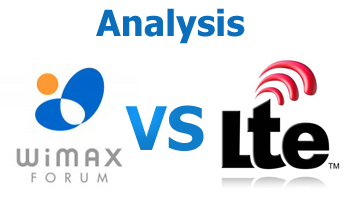
This article tries to describe some comparative points of LTE and WiMax to show their advantages and disadvantages.
1. Time advantage
WiMax is in the market while Long Term Evolution is still in the labs…So, in this point, WiMax has a clear time advantage over LTE: WiMax is present nowadays in numerous countries around the world.
There are already a lot of deployments, and WiMax is growing step by step in different markets, not only in urban zones,but also in rural and/or emerging markets. On the other hand, LTE is still in the labs, and forecasts say that until 2011-2012 (end of 2010 maybe) it will not be in the real market.
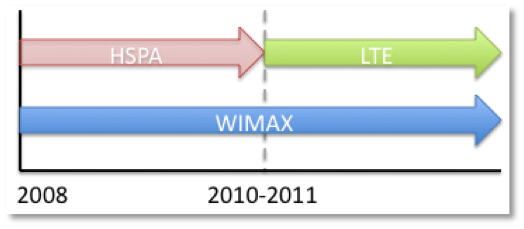
Availability of WiMax, HSPA and LTE
This fact can be an advantage for WiMax, because when LTE has arrived to the telecom market, WiMax will have already a solid market using it’s hardware. However, other technologies, like HSPA+, could decrease that advantage. HSPA+ could compete with WiMax meanwhile LTE arrives.
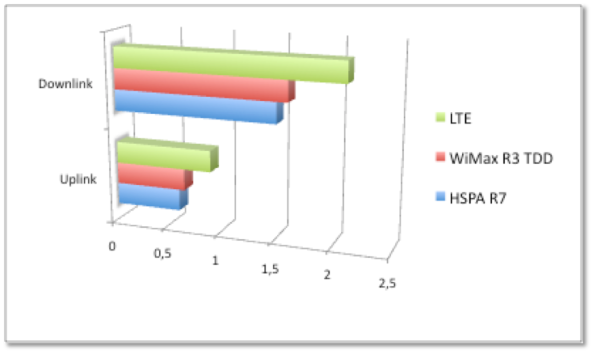
Spectrum efficiency of HSPA, WiMax and LTE in BPS/Hz
As it can be seen in the figure above, HSPA R7 can compete with WiMax R3 TDD in terms of BPS/Hz either in the download link or upload link.
(To read more and see download options: Click “Read More…” below this line)
2. Latency
There is a good difference in the latency of WiMax and LTE, and some “real time” multimedia services will get benefit of this.
Latency is a key point in some online services, and if one wants to deliver these services in a good way, he will need to pay attention to the Latency parameter. In some cases the signal must arrive at its destination as soon as possible, in order to maintain a “real time” sensation during the data exchange over the net.
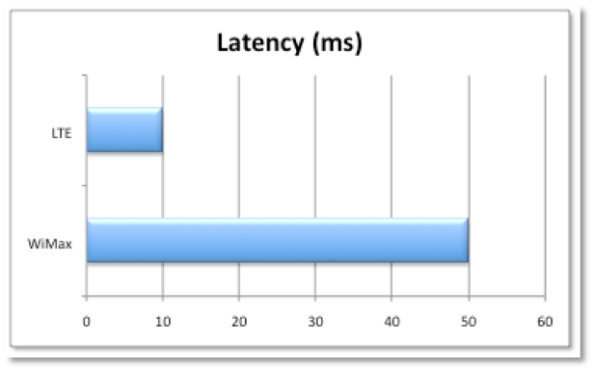
Latency: LTE 10ms WiMax 50ms
Some examples of online services which are sensitive to latency are:
- Online gaming: Online gamers always complain about the “ping”. In competitive gaming it is a huge difference between players if someone of them has 40ms less than others.
- The videoconferences will have better performance, without delays in the conversation. There is a solution to a high latency: the use of buffers, that’s true. But there is a point here for LTE, because it do not need special improvements. Also, WiMax uses a bigger overhead in the packets, and that is worse for services like VoIP.
3. 3GGP Evolution: GSM, HSPA…now LTE
Today, there is an important infrastructure around the entire world that allows users to enjoy mobile coverage. This coverage is possible thank to the deployment of different generations of mobile technologies: 1G, 2G and 3G. This infrastructure follows the 3GGP standards, in terms of nodes and protocols. The money invested in all of these nodes is huge, and operators must maximize the use of these facilities.
Now, 3GGP has researched the next step of the net evolution: LTE. By this reason, LTE seems to be the natural path to GSM and HSPA+. The compatibility between LTE and the other 3GGP’s predecessors will result in a easy re-farming potential and in a easy upgrade possibilities. LTE is fully integrated with 3GGP, so it is fully integrated with previous infrastructure and protocols.

3GPP Standard Evolution
Furthermore, LTE provides FULL mobility. While WiMax needs a mobile target with a speed lower than 120 km/h, LTE still operates with a target up to 350 km/h.
Summarizing this point, the easy re-farming possibilities,the easy upgrade potential and the full mobility, convert LTE in a “natural” evolution from 3G to 3,9G – 4G.
4. Handover and Roaming
LTE supports handover and roaming with the 3GGP mobile networks. However, these services are not easy to achieve with WiMax.
This fact is an important point because the roaming service generates numerous benefits for operators: it extends the coverage of the operator using the network of other carriers, it generates more benefits of visitors from other carriers and it provides to users an important service: One can travel far away from the coverage of his operator and the mobile phone is still functional.
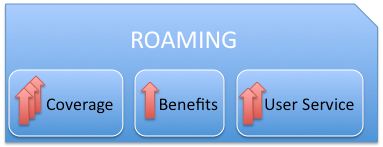
Roaming advantages
5. WiMax, by default with Intel
It seems that Intel will integrate WIMAX in its new devices…It ensures a good number of WiMax devices in the market by default, which is very good to expand the potential market of WiMax.
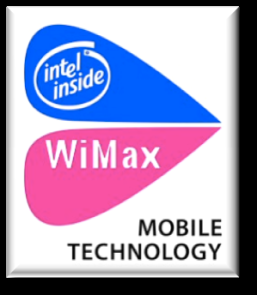
Intel WiMax
6. SIM cards
LTE, like GSM, needs a SIM card to operate. The use of a SIM card has its advantages and also its disadvantages.
On the one hand, with LTE, the use of a SIM card is mandatory for the users and that is a requirement for them, which is not good because the users want things easy, so the less requirements needed the better.
On the other hand, the use of SIM card makes easier to provide some services like roaming, which is a key service nowadays. Identifying subscribers with a SIM makes things easier to the carrier.
7. A lot of big carriers seem to prefer LTE
According to nokiasiemensnetworks.com, there are plenty of telecom carriers around the world that are going to LTE instead of WiMax. Most of them have a GSM infrastructure already deployed, so LTE is a logic step in their evolution to the next 4G (or 3,9G). Some examples of this are:
· Biggest carriers in USA: AT&T, Verizon.
· Vodafone
· China Mobile
· DoCoMo (2010-2011).
· Others: KDDI, Telstra, Telecom Italia, China Telecom, Orange, and T-Mobile.
If the biggest carriers go for LTE, It will produce a lower price of LTE products in terms of fabrication: higher volume of production, lower prices. It could be an important point for LTE.
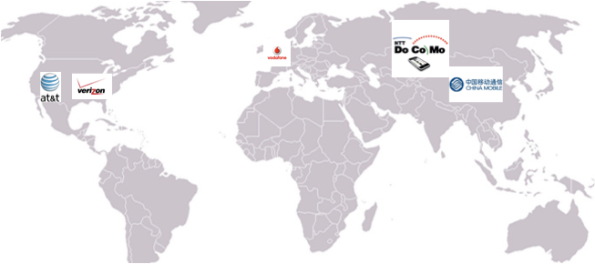
Different carriers with LTE worldwide
8. Developing countries
When developing nations face the problem of deploying a new telecom infrastructure in the country, they usually have 2 important preconditions:
1. They don’t have any GSM inheritance.
2. They need an available technology.
So with these terms, a lot of developing countries (East Asia and Africa have examples of this) are already deploying WiMax.
The initial costs of WiMax are lower when the operators do not have any 2G – 3G equipment, so WiMax could be a good option because the CAPEX of WiMax are lower than the CAPEX of LTE, and the initial investment is a key point in developing countries.
9. Power consumption
LTE needs lower power consumption than WiMax. One of the reasons of this is the use of SC-FDMA modulation in uplink channels.
A low power consumption results in a longer battery life in mobile devices. So LTE has an advantage here, when talking about mobility, the battery life is a main feature of any mobile device like a mobile phone. Talking about bigger devices, like laptops, the battery is not an important issue because batteries of these devices last longer.
10. Different carriers, different scenarios
All points detailed above are important, but the conditions or the characteristics of the carrier/operator will override sometimes those points. Lets see some different scenarios:
- Incumbent 3G operators: Upgrading to HSPA, then LTE.
- New 3G operators: If they want to be a full operator (not only access): Invest in HSPA/UMTS network, then LTE. If they only want to focus on the access: WiMax BWA license.
- New operators without licenses: WiMax in urban areas and WLAN in certain hotspots, for example.
***********************
To see references and more sources of information of this topic, download the Word document.
SlideShare:











Excellent analysis. Helpful and easy to read. Good work!
Hey , Thanks !! good Information
I would like to insist about the second part of the your first point, the efficiency of LTE against WiMax.
I think this is a critical issue in the decission of develop WiMax net or LTE. In this way I read yesterday and interview with Lazaridis (RIM CEO and founder) who prophesied that mobile networks will bring to a standstill unless the operators do something… like LTE.
Thank you for your article, it has sheded about this two methodologies, I see similarities with Blu-ray and HD-DVD.
@Tomas P: About the words of Lazaridis and the possible problems in the network (I just read it today), I am going to publish something related: an article about the problems of the backhaul and the need of an upgrade in the next generation, when LTE/WiMax have arrived.
@Martin, Jagadeesh: Thanks a lot for your comments!
Very good work and excellent post! Thanks.
Good day!
I’ve recently come across
amazing
akne
Hi!
Check out.
fantastic
mittel gegen pickel
Hi everyone!
I’ve recently come across excellent
Schilddruese
łysienie